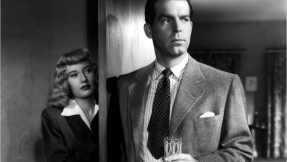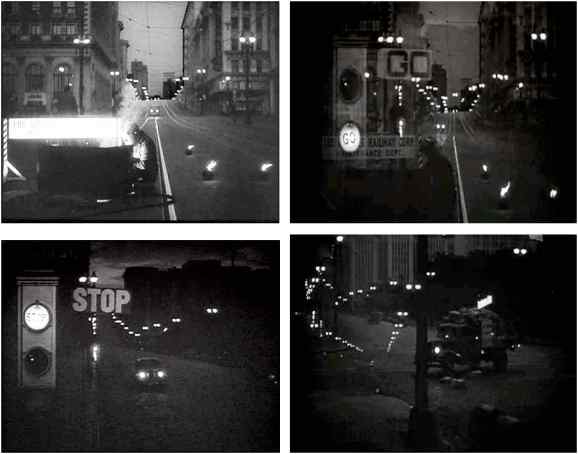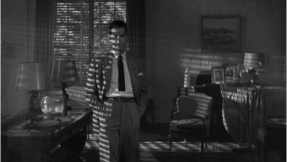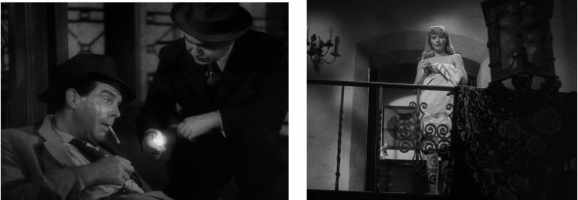Double Indemnity: An In-Depth Look At A Film Noir Classic
By Rachel Elfassy Bitoun | Mar 15, 2014 | Film | 17 comments

‘It has all the characteristics of the classic forties film as I respond to it. It’s in black and white, it has fast badinage, it’s very witty, a story from the classic age. It has Edward G. Robinson, and Barbara Stanwyck and Fred MacMurray and the tough voice-over. It has brilliantly written dialogue, and the perfect score.’ Woody Allen
In many ways, Woody Allen’s quote encompasses all the main elements that make Billy Wilder’s Double Indemnity (Paramount Pictures, USA, 1944) a masterpiece. Anchored in the film noir’s aestheticism, its low-key lighting, oppressive music, sharp dialogues and breathtaking performances achieve to make this film an unavoidable classic.
It is essential to understand the characteristics of film noir’s aesthetic to appreciate Double Indemnity‘s richness. The term has first been used in 1946 by French critics to describe the rise of crime dramas in Hollywood that explored sexual motivations and growing cynicism. Its low-key black and white style is significantly recognizable, influenced by German expressionism and 1930s’ gangster movies. In a good film noir, we expect to encounter feverish desire and transgression, portrayed by sympathetic anti-heroes who remain outside society, in an underworld of misdeeds.
Double Indemnity adopts film noir’s and crime fiction’s properties, and responds to these anticipations. The plot is based around a crime of passion and adultery. The men wear dark suits, gangster-like hats and smoke cigarettes endlessly. The women wear elegant dresses and luxurious jewellery; they move around fluidly to display their sex-appeal. Everything is meant to convey American lifestyle, and Los Angeles transmits a constant air of menace. Richard Schickel writes in his BFI Classics that Wilder has ‘deliciously proved the writerly adage that landscape is character. You could charge LA as a co-conspirator in the crimes this movie relates.’ Thus one of the greatest achievements of Double Indemnity is to create a specific film noir mood of danger and attraction. An atmosphere that echoes the character’s immorality, and that is brilliantly conveyed through the particular use of low-key lighting as a visual representative of the protagonists’ psychological states.
Much has been said about the use of low-key lighting in film noir. Like painters, cinematographers create an effect of chiaroscuro, and darkness tends to dominate the shot composition. Double Indemnity seems to be sculpted by light (and absence of light), anchoring the movie within the film noir tradition. The credits and the opening sequence of the film set the general tone and are representative of the film’s whole aesthetic. The shadow of a man on crutches, in backlight, walks towards us and plunges the screen into darkness. It fades to a deserted street in Los Angeles, at night time. A speeding car appears completely out of control as the haunting, heavy-beat music of the credits changes to a fierce symphony, stressing the urgency of the situation. The car can be seen as a metaphor for the impatient Walter (Fred MacMurray), who has run all the spotlights in his relation with Phyllis (Barbara Stanwyck). In the foreground, workers fix the road and scatter lanterns of fire on the ground. Flames indicate danger, passion and damnation, themes directly addressed by the film. A luminous sign stating “Los Angeles Railway Corp.” ironically foreshadows what will be a major space in the storyline, the train station. The car runs a red light and finally settles in front of a dark building. The only apparent sources of light are the street lamps and the car’s lights, which stay visible during the transition between shots: they allow the dissolves to occur. They remain on screen up to the last second and haunt the audience’s vision, like a guilty man’s consciousness… Hence, the audience is given clues about the themes, the setting, the character’s state of mind and what will happen later, in the space of twenty seconds.

In film noir, lighting implicitly develops key points around the story and the protagonists. It hides them from the audience’s sight, and wraps the plot in enigmas and secret crimes. Yet Double Indemnity adds in an extra layer of complexity – lighting also reveals the hidden evils within the characters. Thus, it is used as a narrative feature which puts aspects of the story and of the characters into visual form. Wilder and his director of photography John Seitz play with light to portray the characters’ conflicting emotions. The juxtaposition of brightness and shadow parallels the unsteady moral consciousness of Phyllis and Walter, who both wobble between good and evil, love and lust, virtue and crime. As Schickel claims, Double Indemnity is ‘a drama about light, about a man lured out of the sunshine and into the shadows‘ . At the beginning of the film, sun covers the city of angels and shines through the blinds of the insurance’s offices and the Dietrichson’s house. It is in this sunny ambiance that Walter meets Phyllis, wrapped in a white towel after sunbathing. Everything shines about her: her jewels, her white dress, her nudity. Walter has been blinded by her, a bright artificial sun, and from there rain and darkness reign. He has literally been taken out of the sunshine into the shadows.


This world of obscurity is also conveyed through the sharp-witted dialogues and the neurotic soundtrack that contribute to the film’s grandeur. Wilder and Raymond Chandler produced jazzy dialogues, with a dark sense of humour. The actors say their lines promptly: they fight each other through speedy cross-talks. Yet Walter and Phyllis both use speech for different purposes, which reveals their diverging intentions. Walter stereotypically calls Phyllis ‘baby’, as if he wanted to possess her. In his apartment, after they have decided to kill Mr. Dietrichson, Walter wishes they had pink wine to celebrate, to create a more romantic atmosphere, but Phyllis dismisses him by saying Bourbon is fine. While his intention is clearly sexual, she wants to get on with the job in the most pragmatic and efficient way. Her intentions are murderous and greedy, and her relation to Walter is purely manipulative.
The voice-over is common in film noir (Wilder uses the same process in Sunset Boulevard) and parallels Cain’s use of the first person narrative. Within the flashback, Walter’s wry voice guides the audience throughout the entire film. Looking at the past, he acknowledges his fatal sexual attraction to Phyllis and is aware of the mistake he has made. ‘I killed him for money and for a woman. I didn’t get the money and I didn’t get the woman.‘ The voice-over builds suspense as we are directly drawn into the story and wonder what has happened. And let’s not forget the music, crucial to the building of the atmosphere. Artfully repetitive, it accompanies the spectator through his investigation of the Dietrichson affair.
Wilder’s direction is impeccable, and actors play their role with dexterity and intelligence. The choice of cast has contributed to the film’s popularity: Barbara Stanwyck was the highest paid actress in America at the time, and Edward G. Robinson had been a star since the successful Little Caesar. Fred MacMurray was more famous in light comedies, but the role of Walter allowed him to show the full variety of his acting talent. But it really is Stanwyck’s sophisticated performance that stands out, still memorable after seventy years. Wilder has said of her that “she was as good as an actress as I have ever worked with. Very meticulous about her work.” At the time, few actresses agreed to play evil women, but Stanwyck took risks and made of Phyllis the perfect femme fatale. She is attractive, alluring, powerful and in control of the situation. Wanting her is fatal. Also, the relationship between Walter and Keyes (Edward G. Robinson) is fundamental, and warmer than in the novel. ‘It’s the love story of the picture’, stated Wilder. Both men complement each other, such as the matches symbolize. Keyes acts as the moral monitor of the story, a figure that Cain could never bring himself to write. Yet it allows the audience to sympathise with Walter, and creates a poignant new ending: he dies in the arms of his friend after confessing, and gets a sentimental farewell from the audience, whereas Phyllis dies alone.

Works Cited
– Blakeney, Catherine, ‘An Analysis of Billy Wilder’s “Double Indemnity”‘, StudentPulse (2009) accessed the 13/02/2014
– Gemünden, Gerd, A foreign affair: Billy Wilder’s American Films (New York: Berghahn Books, 2008)
– Hanson, Helen and O’Rawe, Catherine, The femme fatale: images, histories and contexts (Basingstoke, Hampshire, UK ; New York : Palgrave Macmillan, 2010.)
– Lax, Eric, Woody Allen: A Biography (New York: Alfred A. Knopf Inc, 1991) pp. 37-8.
– Mills, Michael, ‘Double Indemnity: An in-depth look at the classic’, Moderntimes (2007) accessed the 13/02/2014 <http://moderntimes.com/double/>
– Schickel, Richard, BFI Classics Double Indemnity (London: British Film Institute, Palgrave Macmillan, 1992)
http://the-artifice.com/double-indemnity-film-noir-classic/



